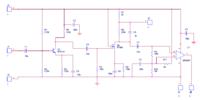areeb
Junior Member level 2
Hi Guys!
I am having problem figuring out a circuit (Attached in the message). I can identify the components individually but I cannot figure out what is the purpose of this circuit or where is it used. It looks like an fm transmitter/receiver/LNA/MIXER circuit, but I am not sure. Any suggestion would be of great help.
Thank you in advance!
Also please let me know the function of pins (I/O) ports shown with question marks on the figure.Thanks
I am having problem figuring out a circuit (Attached in the message). I can identify the components individually but I cannot figure out what is the purpose of this circuit or where is it used. It looks like an fm transmitter/receiver/LNA/MIXER circuit, but I am not sure. Any suggestion would be of great help.
Thank you in advance!
Also please let me know the function of pins (I/O) ports shown with question marks on the figure.Thanks

